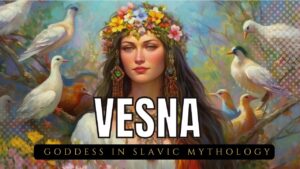Step into the vibrant world of Slavic mythology with our captivating exploration of Vesna, the goddess symbolizing renewal, growth, and fertility. As the harbinger of spring, Vesna’s tale is woven with themes of rejuvenation and the triumphant return of life after the winter’s slumber. People loved Vesna very much because she took the place of Morena, who was cold and dead. For the Slavs, winter was a time of death, even though Morena was the goddess of winter. In the past, winter meant that there wasn’t enough food because of all the illnesses that the cold caused, which were then linked to death. Vesna adorned the lush fields and meadows, the sunny skies, and the good places to live and work. Vesna’s changes to the surroundings made Slavic homes happier. For many people, Vesna was a goddess of youth because spring was a time of great beauty when flowers grew, animals woke up, and everything started over.
Vesna is the goddess of spring, so she is in charge of giving the land its green clothes of new growth. People revered her as one of the most powerful ancient goddesses because her feelings were perfectly balanced with reason and grace. The Old Slavs saw Vesna as a friend. They worshiped her because she was beautiful and kind, and they thought that naming their girls after her would mean that they were just as kind and smart as the goddess.
The best time for Vesna to rule was in the spring, when everything was green and lovely. Because she was the goddess of fertility, the Slavs believed she could bring order back to nature and make life better for everyone. Instead of Morana, they thought Vesna was on their side, and they thought that she helped them get better after the harsh winter by keeping their feelings and thoughts in check in the spring. She did this to make sure that nothing would ever get in the way of the people getting along. She made them good and gentle so that they could grow up respecting and getting along with each other.
The Serbs have usually given girls the name Vesna because of this. People named this kind of daughter Vesna because they thought her sister would be happy and bright, like the goddess Vesna, who means spring. Her name comes from the Indian word Vas, which means “sun,” “light,” and “bright.” The word “vesna” comes from the Slavic word for “vas,” which is also the first letter of the word. Another thing this shows is that the Slavic people worshiped the goddess Vesna before they left India and came to Europe. It is important to remember that Vesna was an example for women most of all. She was beautiful and strong, and she had a wonderful smell that filled the room. It is also said that she gave the Sun its strength, since spring would not come without it.
Old Slavs often thought of her as a pretty, smiling girl who walked around barefoot and had huge breasts, light hair, and pink cheeks. She is wearing clothes made from grass, sticks, leaves, and flowers, and she has a flower in her hair. In her left hand, she holds a fruit bowl, and on her right index finger, a swallow is sitting on her finger. It’s not a surprise that newlyweds liked her; she represented the end of one life and the beginning of a new one. The swallow was seen as a holy bird and a sign of spring because it could return to its breeding grounds after wintering in the south. This is how her month of March got its name.
As soon as it turned green, the farmers lit bonfires and danced inside them to honor her beauty. They asked her for fresh, green food for their animals and for them to have many babies. In honor of Vesna’s birthday, the saying “The sun jumped three times with joy” is used. By setting a doll of the feared goddess Morana on fire, they were freeing themselves from her control. This was a sign that Baba Jaga, Morana’s other self, was no longer able to affect them, and spring would come sooner. When it comes to Morana, the dead person is Vesna’s life, because the two are connected and represent the changing seasons and a never-ending circle of birth and death. The idea that these two gods were so different from each other supports the idea that people thought their gods had human traits like wanting power, being jealous, or being competitive.
Our hearts and face light up again when we think of Vesna. We can read her thoughts and direct our emotions in any way we choose, which lets us get through any problem with her help. Vesna teaches me not to worry and hold back my feelings, but to let them flow freely like spring water on a dry landscape. She teaches us a great lesson about how to get excited and hopeful again. Let’s run barefoot, smell the flowers, show love in nature, be tender with our partners, feel ecstasy, find our life’s purpose, enjoy the present moment, value simplicity, celebrate our bodies, and wear light clothes.
A victory was also portrayed by the goddess Vesna. She had power over the elements and could beat winter and death. The victory was praised in the usual ways. It was said that Stibog took Vesna somewhere every spring on the wings of a soft breeze. It seemed like the Slavs always picked Vesna when Morena and her were in a fight. The Slavs would burn the Morena doll and take the Vesna doll on a branch. This ceremony was a celebration of Vesna’s victory over Morena. Vesna’s win wasn’t final, though, because these cycles happened again and again every year. The fight between Vesna and Morena showed that she was like other humans in that she was tolerant of other women, jealous, and wanted to be in charge.






